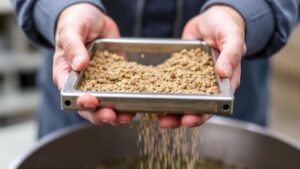How to Choose the Best Gravel Bars for Panning in Fast-Moving Streams
How to Choose the Best Gravel Bars for Panning in Fast-Moving Streams
Panning for gold and other valuable minerals in fast-moving streams can be an exhilarating and rewarding hobby. But, success in gold panning largely depends on selecting the right gravel bars where gold and minerals are likely to accumulate. This article will provide an in-depth exploration of how to identify and choose the best gravel bars for effective panning.
Understanding Gravel Bars
Gravel bars are elevated areas in a stream composed of loose sediments, including sand, gravel, and stones. form due to the natural flow of water, which deposits sediment as currents slow down. Understanding their formation and characteristics is crucial for successful panning. When considering gravel bars, focus on various aspects:
- Location: Gravel bars are typically found at bends in the stream or where the water current weakens.
- Size: Larger gravel bars can accumulate more heavier materials, potentially increasing gold concentration.
- Surface Composition: Look for bars with a mix of gravel, sand, and clay, as these can indicate varied mineral deposits.
Identifying Promising Locations
Knowing where to look is half the battle. Several factors contribute to identifying potentially lucrative gravel bars:
- Stream Dynamics: Observe how water flows around obstacles. Gold often concentrates behind rocks or at the base of gravel bars due to its density.
- Vegetation: Presence of certain plants can indicate stable soil and sediment accumulation, pointing to potential gold concentrations.
- Coloration: Dark patches in the gravel may indicate clay, which often traps heavier materials like gold.
Timing and Seasonal Considerations
The time of year significantly affects gravel bar conditions and accessibility. Certain seasons are better for panning:
- Post-Rain Events: Following heavy rain, streams can shift, revealing new gravel bars.
- Spring Melting: As snow melts, water levels rise, potentially exposing new panning sites.
- Low Flow Periods: Late summer and early fall often see decreased water levels, making gravel bars more accessible.
Safety Considerations
Before heading out to pan for gold, it is essential to prioritize safety. Fast-moving streams can pose serious risks; therefore, consider these precautions:
- Wear Appropriate Gear: Waterproof boots, gloves, and a personal flotation device can enhance safety in slippery conditions.
- Avoid Solo Trips: Panning with a partner can mitigate risks in case of accidents.
- Be Aware of Weather Conditions: Sudden changes in weather can increase stream flow rapidly, leading to dangerous conditions.
Practical Techniques for Panning
Once youve identified a suitable gravel bar, effective panning techniques are vital for maximizing success:
- Scoop and Pan: Use a plastic or metal pan to scoop gravel, ensuring that you include both coarse and fine materials.
- Stratification: Layer your material by size, starting with the largest rocks; lighter materials will wash away first.
- Control Water Flow: Tilt the pan to let water flow through, allowing lighter sediments to wash off while heavier minerals settle at the bottom.
Real-World Application: Case Studies
Several regions in the United States have long been recognized as hotspots for gold panning, such as the Sierra Nevada in California. Here, amateur prospectors often report success by carefully selecting gravel bars along river bends where the current slows, allowing for the deposition of heavier metals. Similarly, the streams in the Appalachian Mountains have also yielded significant finds due to the natural landscape supporting stable gravel deposits.
Conclusion
Choosing the right gravel bars for panning in fast-moving streams requires a combination of observation, timing, safety, and technique. By understanding the dynamics of stream sedimentation and adhering to the precautions highlighted above, enthusiasts can significantly improve their chances of successfully finding gold and other minerals. As always, remember to respect natural habitats and follow local regulations while panning.
By following this guide, you can embark on a fulfilling panning adventure equipped with the knowledge necessary for success.


